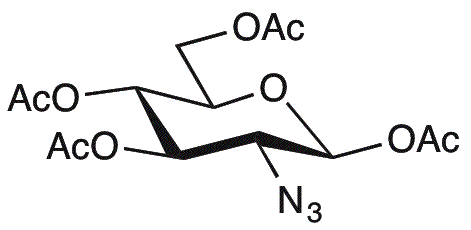2-Azido-b-D-glucose tetraacetate is widely utilized in research focused on:
- Bioconjugation: This compound serves as a versatile building block for attaching biomolecules, such as proteins or antibodies, to surfaces or other molecules, enhancing drug delivery systems.
- Click Chemistry: It plays a crucial role in click chemistry reactions, allowing for efficient and selective reactions that can be used in creating complex molecular structures in pharmaceuticals.
- Carbohydrate Chemistry: Researchers leverage its properties to study glycosylation processes, aiding in the synthesis of glycosylated compounds which are important in vaccine development.
- Diagnostics: The azido group can be utilized in imaging techniques, helping to label and visualize biomolecules in various diagnostic applications.
- Material Science: This compound is explored for functionalizing surfaces in nanotechnology, improving the performance of materials used in electronics and sensors.
General Information
Properties
Safety and Regulations
Applications
2-Azido-b-D-glucose tetraacetate is widely utilized in research focused on:
- Bioconjugation: This compound serves as a versatile building block for attaching biomolecules, such as proteins or antibodies, to surfaces or other molecules, enhancing drug delivery systems.
- Click Chemistry: It plays a crucial role in click chemistry reactions, allowing for efficient and selective reactions that can be used in creating complex molecular structures in pharmaceuticals.
- Carbohydrate Chemistry: Researchers leverage its properties to study glycosylation processes, aiding in the synthesis of glycosylated compounds which are important in vaccine development.
- Diagnostics: The azido group can be utilized in imaging techniques, helping to label and visualize biomolecules in various diagnostic applications.
- Material Science: This compound is explored for functionalizing surfaces in nanotechnology, improving the performance of materials used in electronics and sensors.
Documents
Safety Data Sheets (SDS)
The SDS provides comprehensive safety information on handling, storage, and disposal of the product.
Product Specification (PS)
The PS provides a comprehensive breakdown of the product’s properties, including chemical composition, physical state, purity, and storage requirements. It also details acceptable quality ranges and the product's intended applications.
Certificates of Analysis (COA)
Search for Certificates of Analysis (COA) by entering the products Lot Number. Lot and Batch Numbers can be found on a product’s label following the words ‘Lot’ or ‘Batch’.
*Catalog Number
*Lot Number
Certificates Of Origin (COO)
This COO confirms the country where the product was manufactured, and also details the materials and components used in it and whether it is derived from natural, synthetic, or other specific sources. This certificate may be required for customs, trade, and regulatory compliance.
*Catalog Number
*Lot Number
Safety Data Sheets (SDS)
The SDS provides comprehensive safety information on handling, storage, and disposal of the product.
DownloadProduct Specification (PS)
The PS provides a comprehensive breakdown of the product’s properties, including chemical composition, physical state, purity, and storage requirements. It also details acceptable quality ranges and the product's intended applications.
DownloadCertificates of Analysis (COA)
Search for Certificates of Analysis (COA) by entering the products Lot Number. Lot and Batch Numbers can be found on a product’s label following the words ‘Lot’ or ‘Batch’.
*Catalog Number
*Lot Number
Certificates Of Origin (COO)
This COO confirms the country where the product was manufactured, and also details the materials and components used in it and whether it is derived from natural, synthetic, or other specific sources. This certificate may be required for customs, trade, and regulatory compliance.


